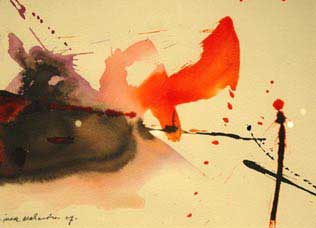Mahendra Mangku Exhibition: Sanur Bali
 Mahendra Mangku loves challenges. He yearns for struggles. Life has always been a struggle for him. And he keeps fighting back with joyful enthusiasm, a strong sense of self-confidence and a wicked sense of humor.
Mahendra Mangku loves challenges. He yearns for struggles. Life has always been a struggle for him. And he keeps fighting back with joyful enthusiasm, a strong sense of self-confidence and a wicked sense of humor.
Once, a friend teased Mangku about the physical disability in one of his legs. The handicap had forced Mangku to walk with a limp.
Instead of erupting with rage, Mangku offered an alternative, humorous view on his awkward gait: “Well, haven’t you noticed that all racing bikes use a mono-shock absorber instead of a dual one? It must be because mono shock is better than dual shock. It certainly is priced higher on the market than the dual one.”
And the two burst into laughter.
Mangku treats his art with a similar attitude. He embraces challenges warmly, tackling various difficulties with the combined force of hard work and optimism.
It is no wonder that his artistic career has been filled with nothing but creativity and productivity. So far, the 34-year-old painter has participated in over 50 exhibitions in various cities across Indonesia, the U.S. and Singapore. He has also received several commendations, including from the Ministry of Culture and Tourism and his alma mater, the Indonesian Fine Arts Institute (ISI).
“My art is always about anxiety, about struggles. Anxieties about life as well as about artistic exploration. Therefore, I keep looking for new challenges, new territories, new things,” said Mangku. “Only by doing so, I believe an artist has a chance to grow, to be more mature.”
Naturally, he wanted to grow beyond canvas and acrylic, as he felt a strong urge to tackle different mediums. So he chose paper as his next challenge.
The reason was quite simple: paper and watercolor are the outcasts in the present realm of Indonesian contemporary paintings. Paper and watercolor were that damaged leg, that wobbling limp, and Mangku was determined to show everybody that, once again, mono shock was no less powerful — or valuable — than dual shock.
Last Friday, Mangku presented his proof on the inspiring quality of watercolor paintings in a solo exhibition titled simply, Works on Paper, which opened at the Griya Santrian gallery in Sanur. The island’s most celebrated painter, I Nyoman Gunarsa, practically ran into rapture as he opened the exhibit.
“Creating a watercolor painting brings a surge of intoxicating happiness to the heart of a painter, because watercolors demand spontaneity, precision and bravery all at the same time,” he said. “There is no room for mistakes. Once you move the brush there will be no turning back. You can neither erase it nor repeat it.”
The exhibition pieces clearly reveal that Mangku has succeed in overcoming the challenges presented by both paper and watercolor. The simple lines, gentle strokes, fluid forms and, most importantly, the exquisite colors emerge as a single, unified, meaningful arrangement borne out of one painter’s esthetic consciousness.
“Although his style is abstract, Mangku’s paintings are not created out of a void. Mangku strongly believes that abstract painting originates from and enhances nature,” art critic Arief B. Prasetyo commented.
Naturally, imageries of the natural world frequent Mangku’s abstract expressions.
“Viewers will not find it difficult to imagine panoramic views of mountains or sparkling beaches, mystical mist and stretching horizons, hidden behind layers of abstracted forms and shapes in Mangku’s works,” Arief added.
Exhibition curator I Wayan Sukra went even further, defining the event as a turning point in Mangku’s artistic journey.
“In this exhibition, Mahendra Mangku makes works that are physically, emotionally or conceptually distanced from the ‘pure’ abstraction of his earlier periods,” he said.
By isolating the elements of the language of painting for examination, celebration or deconstruction, Sukra argued, Mangku had refreshed our understanding of what painting could be.
“Disregarding hard classification between media or styles, Mangku feels free to straddle categories, to take creative risks by inhabiting hybrid territories — for example, when he mixes representational painting with issues of abstraction,” he said.
Finally, Sukra proclaimed that Mangku had showed that the possibilities that abstract painting offered today were as rich and rewarding as a century ago.
Refusing to use any difficult and technical terminology the likes of which art critics and curators generally love to play with, Mangku defined the exhibition as a coming home.
“There was a period in the past when I painted small, insignificant, mundane things. I want to do it again. I want to paint a cactus or a slab of rock and see how they evolve in my hand, my mind,” he said.
The cactus evolved into a green, spiky object while the slab of rock grew into a square-like arrangement of subdued blue, mossy green and calm yellow.
The paintings of the cactus and the rocks are part of the 44 works being displayed in the exhibit until June 30.
“The exhibit highlights my longing for the past and my desire to prove that watercolor paintings are no less beautiful than acrylic ones,” Mangku stressed.
The works are a final confirmation that, when it comes to painting and esthetic journeys, Mangku can travel faster and farther than the rest — even walk on water, perhaps.
Works on Paper
by Made Mahendra Mangku
May 4-June 30
Griya Santrian gallery
Jl. Danau Tamblingan 47
Sanur; (0361) 288181
I Wayan Juniartha